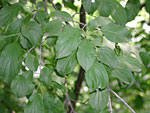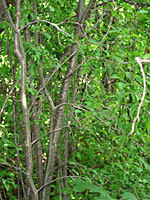By Art Hughes
Minnesota Public Radio
September 3, 2002
Hundreds of volunteers are gearing up for the annual battle against the invasive hedge plant, buckthorn. Members of neighborhood groups, church organizations, and other clubs hunt the troublesome shrub in the fall because it stays green longer than many other plants. Efforts to fight buckthorn in the Twin Cities were given a boost this year by a grant from the U.S. Department of Agriculture.
| |
|
|
|
||
Part of the Twin Cities buckthorn removal campaign will focus on forested areas. But the plan also includes identifying buckthorn on private property, and getting homeowners to voluntarily remove it.
Shanna Hendrickson is a Natural Resource Coordinator with the Minneapolis Park and Recreation Board. She says city crews and volunteers have made progress in some places, like around the lakes. But the city has large infestations in places like Theodore Wirth park in North Minneapolis. Buckthorn removal has never been organized there.
Hendrickson says the spindly, non-descript plant is on it's way to taking over Minnesota forests.
"It's a little darker green, it's shrubby looking ... you know, dense when you drive around. That's what catches your eye in the understory," Hendrickson says. "We don't have a lot of other native shrubs that are getting in there well enough, like chokecherry, things like that. If you see a dense thicket, it's most likely filled with that buckthorn."
Like many noxious plants, buckthorn was introduced to this country by a well-meaning home gardener. Buckthorn is a popular hedge for precisely the reason it's such a problem in wild areas: it grows quickly and provides a wall of dense, green vegetation.
In Minnesota's wild forests it muscles out not just native underbrush plants, but prevents other, larger tree sprouts from developing. If left unchecked, some experts say buckthorn will become the state's predominant forest plant.
Minneapolis and St. Paul each got $80,000 from the USDA to remove invasive species. Each city is giving $10,000 of that to neighborhood volunteers, church groups and even Boy Scout troops. They'll spend the money to educate property owners and identify buckthorn in residential areas. The rest of the money goes to park crews to pull out buckthorn and other invasive species on public land. Minneapolis is focusing much of its energy on the Mississippi River gorge.
| |
|
|
|
||
"You can see the tall big bluestem in the distance there," says Carolyn Carr. She's looking out over a colorful meadow a few steps off of West River Parkway in southeast Minneapolis. Carr is chair of the Longfellow Community Council's River Gorge Committee. "That's going to seed this time of year. And other prairie species ... the yellow oxeye and grey-headed coneflower and goldenrod are blooming right now," she says.
A few years ago the meadow was an impassable green tangle. Carr says clearing buckthorn from the river gorge results in more than just a pleasing vista.
"The gorge is a huge natural area, huge by city standards, that's right here part of our neighborhood," she says. "It's essential habitat along the Mississippi River flyway where birds are migrating through back and forth, insects are passing through. It's critical habitat."
Later this month, Longfellow expects some 200 volunteers for what organizers hope will be an annual buckthorn clearing party. Carr says she allows herself to envision a time when buckthorn is no longer a threat. She says she's spurred on by the places where the determined shrub is kept at bay.
"Coming down here in the spring and seeing the understory of trillium and there's a yellow bellflower. There are a number of really beautiful spring ephemerals and those are the ones that get shaded out over the years of the buckthorn getting too thick," she says. "So to see them back and growing so nicely out on your morning walk or out with your friends or out with your dog, it's a great thing."
Minneapolis officials estimate the areas they've cleared of buckthorn in the river gorge this year add up to only about 15 acres. No one has calculated the acres where buckthorn remains a problem.


